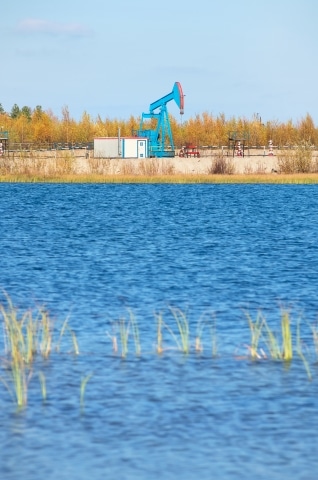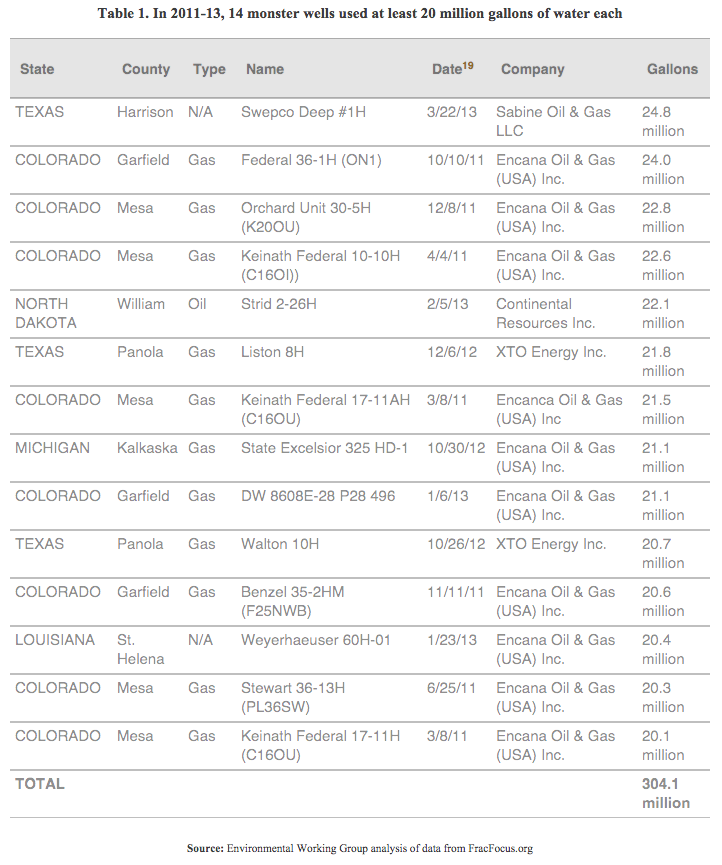While the oil and gas industry likes to claim that fracking is not an especially water intensive process, a new report has found that there are more than 250 wells across the country that each require anywhere from 10 to 25 million gallons of water.
The American Petroleum Institute suggests that the typical fracked well uses “the equivalent of the volume of three to six Olympic sized swimming pools,” which works out to 2-4 million gallons of water.
But using data reported by the industry itself and available on the FracFocus.org website, Environmental Working Group has determined that there are at least 261 wells in eight states that used an average of 12.7 million gallons of water, adding up to a total of 3.3 billion gallons, between 2010 and 2013. Fourteen wells used over 20 million gallons each in that time period (see chart below).
According to EWG, some two-thirds of these water-hogging wells are in drought-stricken areas. Many parts of Texas, for instance, are suffering through a severe and prolonged drought, yet the Lone Star State has by far the most of what EWG calls “monster wells” with 149. And 137 of those were found to be in abnormally dry to exceptional drought areas.
Texas also has the dubious distinction of having the most wells using fresh water in the fracking process. In 2011 alone, more than 21 billion gallons of fresh water were used for fracking Texas wells. Increased pumping by companies seeking to extract the oil and gas in the Eagle Ford shale formation, meanwhile, has been cited as a major cause of the state’s rapidly declining groundwater levels.
Other states with monster wells are Pennsylvania (39 wells that used more than 384 million gallons of water in total), Colorado (30 wells that used 470 million gallons), Oklahoma (24 wells that used 302 million gallons), and North Dakota (11 wells that used 129 million gallons of water). Louisiana and Mississippi each have three monster wells, and Michigan has two.
Here are the biggest monster wells in the country:
Click chart to view larger size.
There is no way of knowing just how much water is being used for fracking, however, because while the controversial well stimulation technique is known to be used in 36 states, only 15 require reporting to FracFocus, and none of the numbers that do get reported are vetted by any kind of regulatory agency or independent authority.
Even the data that does get reported is incomplete. EWG says that for 38 of the 261 monster wells, FracFocus did not even identify such basic information as whether the wells were drilled for oil or natural gas, or what kind of water they used.
Fracking has also been heavily criticized for exacerbating California’s extreme drought conditions, even though fracking in the Golden State doesn’t require as much water as it does in states like Texas and Pennsylvania. A state regulatory agency recently confirmed that nine injection wells were dumping oil industry wastewater into aquifers protected by state and federal law.
Once water is contaminated by the chemicals used in fracking, it has to be permanently removed from the water cycle.
Subscribe to our newsletter
Stay up to date with DeSmog news and alerts








